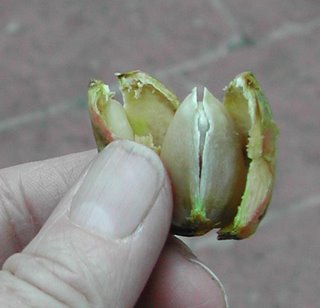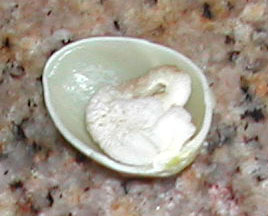 These are the green nuts picked right from the tree. They have a fruity hull that turns black if not removed soon after picking.
These are the green nuts picked right from the tree. They have a fruity hull that turns black if not removed soon after picking.
We sold green nuts at the Farmer’s Market. Most Americans are not familiar with green nuts because the nuts don’t keep well in this stage. SB Pistachio Company only sells green nuts at the Farmer’s Market and only during the harvest. They are picked the day before the market, sorted, and bagged by hand.
You must remove the soft hull to find the hard-shelled moist nut inside. In Iran, they boil the husks to make a jam. I talked with a woman at the Santa Monica Farmer’s Market who told me her mom made jams from the hulls, but she never learned the recipe from her mom.
 This pistachio has opened naturally on the tree. That means it is fully developed. The raw (undried) pistachio tastes fruity and a little citrusy. The texture is more fruitlike. It doesn’t have the crunch of a dried pistachio.
This pistachio has opened naturally on the tree. That means it is fully developed. The raw (undried) pistachio tastes fruity and a little citrusy. The texture is more fruitlike. It doesn’t have the crunch of a dried pistachio.
At the processor, the husks are removed. Open ended pistachios are sorted from closed-shell pistachios. Closed-shell pistachios are shelled and sold as kernels. This harvest brought in 80% open ended nuts.
Remember when we used to buy pistachios in red or green shells? They were dyed to mask the stains left from hulls that weren’t removed quickly enough. Hmm, I think I probably ingested a lot of red dye using my teeth to pry open red pistachios.
 Here is a freshly picked pistachio that didn’t develop. I’m guessing that’s because pollen from the male tree didn’t reach this flower. A lot of the nuts that don’t shake off the tree easily contain these undeveloped pistachios that look a bit like embryos. The shells on these are tightly closed. But some of the closed-shell pistachios do contain fully developed kernels.
Here is a freshly picked pistachio that didn’t develop. I’m guessing that’s because pollen from the male tree didn’t reach this flower. A lot of the nuts that don’t shake off the tree easily contain these undeveloped pistachios that look a bit like embryos. The shells on these are tightly closed. But some of the closed-shell pistachios do contain fully developed kernels.
Closed-shell pistachios are put into a water bath to separate the heavier “sinkers” containing fully developed kernels from the “floaters,” which aren’t worth cracking open.
